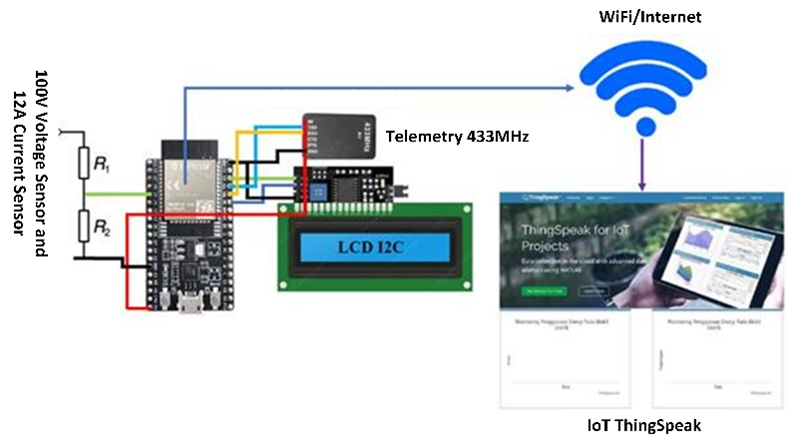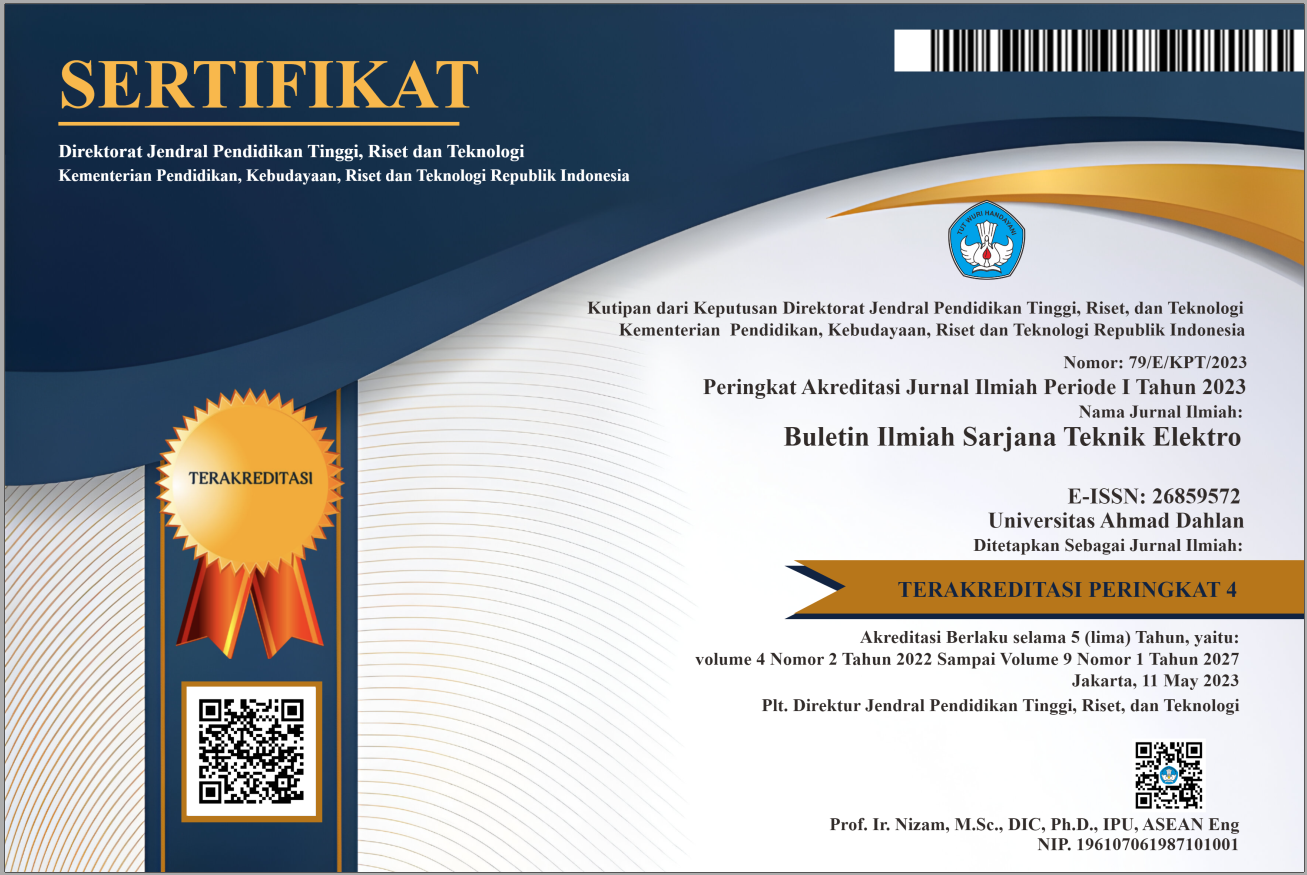Battery Usage Monitoring System Internet of Things-Based Electric Cars (IoT) and Radio Telemetry
DOI:
https://doi.org/10.12928/biste.v6i3.11524Keywords:
Internet of Things, Telemetry, Voltage Divider, Current Sensor, ESP32Abstract
Making electric cars at Ahmad Dahlan University has started since 2019. The implementers in making this electric car are students from the Faculty of Teacher Training and Education, Automotive Technology Vocational Education Study Program and Faculty of Industrial Technology, Electrical Engineering Study Program which started by taking part in a Comparative Study at a Contest Indonesian Electric Car 2019. 2019 at Bandung State Polytechnic. The IoT and Radio Telemetry Based Electric Car Energy Usage Monitoring System created by researchers uses voltage sensor components and current sensors to detect voltage and current in electric cars, NodeMCU ESP32 as a microcontroller, voltage sensors to detect voltage, current sensors to detect current in car electricity and LCD as a reading output from the sensor. Also using IoT ThingSpeak as a display of sent sensor readings requires an internet connection to the microcontroller and radio telemetry as a display of sensor data on a serial monitor without requiring an internet connection. As a result, the tool created can monitor voltage and current accurately from a distance as long as it is connected to the internet and not connected to the internet. The best parameters obtained are the voltage and current sensors because the difference in reading error values from the sensor to the device does not reach 2, therefore they are the best parameters for this monitoring system.
References
H. Liu, "Application research of computer monitoring system based on ubiquitous power Internet of things in substation," 2022 2nd International Conference on Networking, Communications and Information Technology (NetCIT), 2022, pp. 20-24, 2022, https://doi.org/10.1109/NetCIT57419.2022.00012.
E. Lobato et al., “A monitoring system for electric vehicle charging stations: A prototype in the amazon,” Energies, vol. 16, no. 1, p. 152, 2022, https://doi.org/10.3390/en16010152.
M. O. Hasanuddin, R. Augeetiansyah, G. A. Prakoso and B. R. Hermanto, "Design and Implementation of IMU, BLE Proximity and GPS-Based Theft Detection System," 2022 12th International Conference on System Engineering and Technology (ICSET), Bandung, Indonesia, 2022, pp. 1-5, 2022, https://doi.org/10.1109/ICSET57543.2022.10010979.
A. I. Firmansyah, N. K. Supriatna, Y. Gunawan, G. T. Setiadanu and Slamet, "Performance Testing of Electric Motorcycle Conversion," 2022 7th International Conference on Electric Vehicular Technology (ICEVT), pp. 165-168, 2022, https://doi.org/10.1109/ICEVT55516.2022.9924921.
M. S. R. Ganesh, K. S. D. Harshitha, K. P. Darshini, B. S. Lohitha, G. N. S. Aishwarya and K. Utpreksha, "Development of Restructured Electric Vehicle with Battery Charge Monitoring System using IoT," 2024 1st International Conference on Innovative Sustainable Technologies for Energy, Mechatronics, and Smart Systems (ISTEMS), pp. 1-6, 2024, https://doi.org/10.1109/ISTEMS60181.2024.10560154.
N. Hou and Y. W. Li, "Overview and Comparison of Modulation and Control Strategies for a Nonresonant Single-Phase Dual-Active-Bridge DC–DC Converter," in IEEE Transactions on Power Electronics, vol. 35, no. 3, pp. 3148-3172, 2020, https://doi.org/10.1109/TPEL.2019.2927930.
H. Tran-Dang, N. Krommenacker, P. Charpentier and D. -S. Kim, "Toward the Internet of Things for Physical Internet: Perspectives and Challenges," in IEEE Internet of Things Journal, vol. 7, no. 6, pp. 4711-4736, 2020, https://doi.org/10.1109/JIOT.2020.2971736.
B. O. Varga, A. Sagoian, and F. Mariasiu, “Prediction of electric vehicle range: A comprehensive review of current issues and challenges,” Energies, vol. 12, no. 5, p. 946, 2019, https://doi.org/10.3390/en12050946.
M. Wang, C. Yang, W. Wang, Z. Lu, L. Yang and R. Chen, "An Efficient Power Control Scheme for Heavy-Duty Hybrid Electric Vehicle With Online Optimized Variable Universe Fuzzy System," in IEEE Transactions on Fuzzy Systems, vol. 32, no. 5, pp. 2725-2737, 2024, https://doi.org/10.1109/TFUZZ.2024.3359414.
K. M, A. A, K. Balachander, M. S. Ramkumar, G. Emayavaramban and S. Divvapriva, "IoT Based Design and Implementation of Hybrid Electric Vehicle Using Control of DC Motor," 2021 5th International Conference on Trends in Electronics and Informatics (ICOEI), pp. 382-387, 2021, https://doi.org/10.1109/ICOEI51242.2021.9452868.
V. Rahatal, P. More, M. Salunke, S. Makeshwar and R. D. Joshi, "IoT Based Communication System for Autonomous Electric Vehicles," 2021 7th International Conference on Signal Processing and Communication (ICSC), pp. 66-72, 2021, https://doi.org/10.1109/ICSC53193.2021.9673164.
C. L. Nge, I. U. Ranaweera, O. M. Midtgård, and L. Norum, “A real-time energy management system for smart grid integrated photovoltaic generation with battery storage,” Renewable energy, vol. 130, pp. 774-78, 2019, https://doi.org/10.1016/j.renene.2018.06.073.
R. G. Congalton and K. Green. Assessing the accuracy of remotely sensed data: principles and practices. CRC press. 2019. https://doi.org/10.1201/9780429052729.
P. Hoddie and L. Prader. IoT Development for ESP32 and ESP8266 with JavaScript: A Practical Guide to XS and the Moddable SDK. Berkeley, CA, USA: Apress. 2020. https://doi.org/10.1007/978-1-4842-5070-9.
S. Singh and J. Malik, “Review of efficiency enhancement techniques and linearization techniques for power amplifier,” International Journal of Circuit Theory and Applications, vol. 49, no. 3, pp. 762-777, 2021, https://doi.org/10.1002/cta.2956.
D. Mohanraj et al., "A Review of BLDC Motor: State of Art, Advanced Control Techniques, and Applications," in IEEE Access, vol. 10, pp. 54833-54869, 2022, https://doi.org/10.1109/ACCESS.2022.3175011.
B. J. S. Bayu, G. A. P. Gurum, A. R. Agus, and A. Surtono, “Design and Build Voltage and Current Monitoring Parameters Device of Rechargeable Batteries in Real-Time Using the INA219 GY-219 Sensor,” Journal of Energy, Material, and Instrumentation Technology, 4(2), 58-71, 2023, https://doi.org/10.23960/jemit.v4i2.137.
V. Vaideeswaran, S. Bhuvanesh and M. Devasena, "Battery Management Systems for Electric Vehicles using Lithium Ion Batteries," 2019 Innovations in Power and Advanced Computing Technologies (i-PACT), pp. 1-9, 2019, https://doi.org/10.1109/i-PACT44901.2019.8959965.
F. Zhang, L. Wang, S. Coskun, H. Pang, Y. Cui, and J. Xi, “Energy management strategies for hybrid electric vehicles: Review, classification, comparison, and outlook,” Energies, vol. 13, no. 13, p. 3352, 2020, https://doi.org/10.3390/en13133352.
S. Sadowski and P. Spachos, “Wireless technologies for smart agricultural monitoring using internet of things devices with energy harvesting capabilities,” Computers and Electronics in Agriculture, vol. 172, p. 105338, 2020, https://doi.org/10.1016/j.compag.2020.105338.

Published
How to Cite
Issue
Section
License
Copyright (c) 2024 Ahmad Firdaus Hasibuan, Alfian Ma’arif

This work is licensed under a Creative Commons Attribution-ShareAlike 4.0 International License.
Authors who publish with this journal agree to the following terms:
- Authors retain copyright and grant the journal right of first publication with the work simultaneously licensed under a Creative Commons Attribution License that allows others to share the work with an acknowledgment of the work's authorship and initial publication in this journal.
- Authors are able to enter into separate, additional contractual arrangements for the non-exclusive distribution of the journal's published version of the work (e.g., post it to an institutional repository or publish it in a book), with an acknowledgment of its initial publication in this journal.
- Authors are permitted and encouraged to post their work online (e.g., in institutional repositories or on their website) prior to and during the submission process, as it can lead to productive exchanges, as well as earlier and greater citation of published work (See The Effect of Open Access).
This journal is licensed under a Creative Commons Attribution-ShareAlike 4.0 International License.


